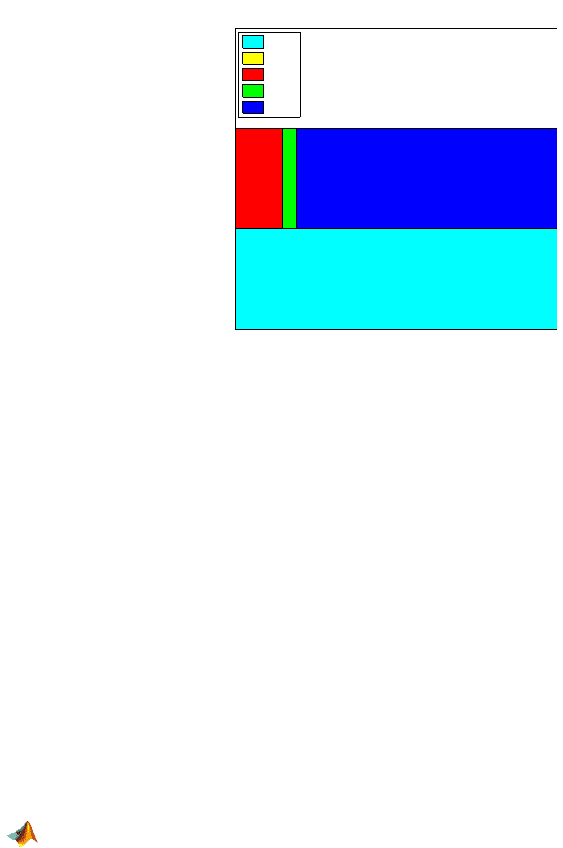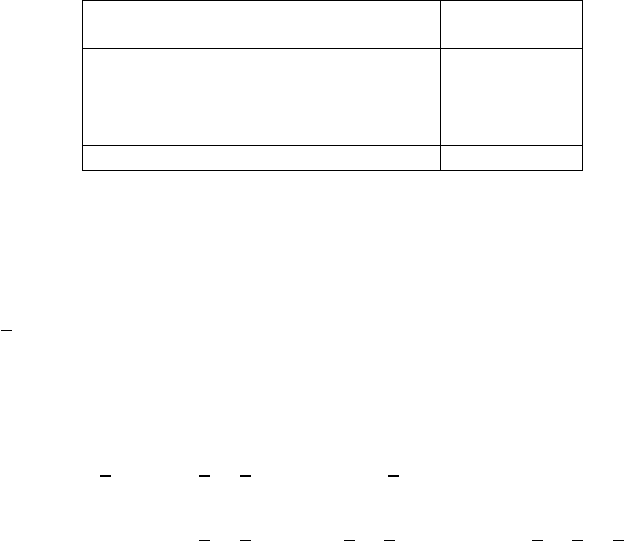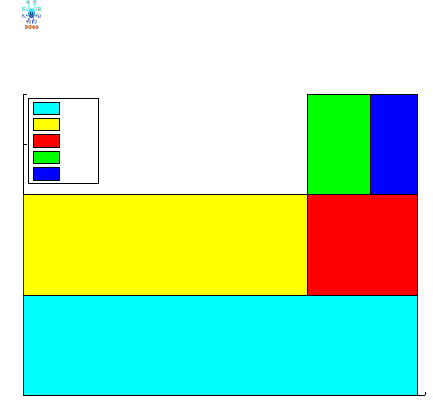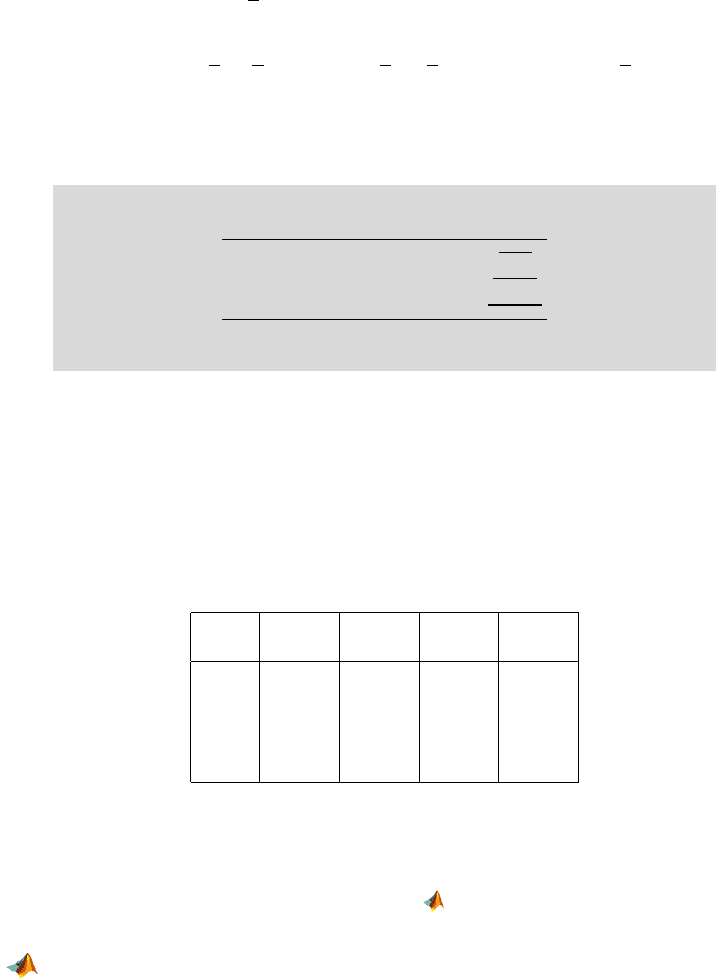Vidakovic B. Statistics for Bioengineering Sciences: With Matlab and WinBugs Support
Подождите немного. Документ загружается.


11.3 Two-Way ANOVA and Factorial Designs 429
have levels 1 and 2. The y-axis contains the means of response (IL-10). The
circles in both plots correspond to the cell means.
For example, in Fig. 11.3a x-axis has two levels of factor HEC. The means
of IL-10 for LPS=1 are connected by the red line, while the means for LPS=2
are connected by the black line. When the lines on the plots are approximately
parallel, the interaction between the factors is absent. Thus, the interaction
plots serve as exploratory tools to check if the interaction term should be in-
cluded in the ANOVA model. Note that some interaction between LPS and
HEC is present (the lines are perfectly parallel); however, this interaction was
found not statistically significant (p-value of 0.2334).
Next, we visualize the ANOVA fundamental identity.
%insulin.m continued
SSA = table{2,2}; SSB = table{3,2}; SSAB=table{4,2};
SSE=table{5,2}; SST = table{6,2};
%Display the budget of Sums of Squares
H=figure;
set(H,’Position’,[400 400 400 400]);
y=[0 0 1 1];
hold on
h1=fill([0 SST SST 0],y,’c’);
y=y+1;
h2=fill([0 SSA SSA 0],y,’y’);
h3=fill([0 SSB SSB 0]+SSA,y,’r’);
h4=fill([0 SSAB SSAB 0]+SSA+SSB,y,’g’);
h5=fill([0 SSE SSE 0]+SSA+SSB+SSAB,y,’b’);
y=y+1;
h6=fill([0 SST SST 0],y,’w’);
hold off
legend([h1 h2 h3 h4 h5],’SST’,’SSA’,’SSB’,’SSAB’,’SSE’,...
’Location’,’NorthWest’)
title(’Sums of Squares’)
Figure 11.4 shows the budget of sums of squares in this design. It is graph-
ical representation of SST
= SS A +SSB +SS AB + SSE. It shows the con-
tributions to the total variability by the factors, their interaction and the er-
ror. Note that the sum of squares attributed to LPS (in yellow) is not visi-
ble in the plot. This is because its relative contribution to SST is very small,
0.0073/49.8539
<0.00015.
The ANOVA table and both Figs. 11.3 and 11.4 are generated by file
insulin.m. For a Bayesian solution of this example consult insulin.odc.

430 11 ANOVA and Elements of Experimental Design
0 10 20 30 40
0
0.5
1
1.5
2
2.5
3
Sums of Squares
SST
SSA
SSB
SSAB
SSE
Fig. 11.4 Budget of sums of squares for Insulin example.
11.4 Blocking
In many cases the design can account for the variability due to subjects or to
experimental runs and focus on the variability induced by the treatments that
constitute the factor of interest.
Example 11.5. Blocking by Rats. A researcher wishes to determine whether
or not four different testing procedures produce different responses to the con-
centration of a particular poison in the blood of experimental rats. To mini-
mize the influence of rat-to-rat variability, the biologist selects four rats from
the same litter. Each of the four rats is given the same dose of poison per gram
of body weight and then samples of their blood are tested by the four test-
ing methods administered in random order. There are 4 different litters each
containing 4 rats for a total of 16 animals involved.
concentration = [9.3 9.4 9.2 9.7 9.4 9.3 9.4 9.6 ...
9.6 9.8 9.5 10.0 10.0 9.9 9.7 10.2];
procedure = [1 2 3 4 1 2 3 4 1 2 3 4 1 2 3 4];
litter = [1 1 1 1 2 2 2 2 3 3 3 3 4 4 4 4];
[p,table,stats,terms]=anovan(concentration,{procedure,litter},...
’varnames’,char(’Procedure’,’Rat’))
%p = 1.0e-003
*
%
% 0.8713
% 0.0452
%
%table =

11.5 Repeated Measures Design 431
% ’Source’ ’Sum Sq.’ ’d.f.’ ’Singular?’ ’Mean Sq.’
% ’Procedure’ [0.3850] [ 3] [ 0] [ 0.1283]
% ’Rat’ [0.8250] [ 3] [ 0] [ 0.2750]
% ’Error’ [0.0800] [ 9] [ 0] [ 0.0089]
% ’Total’ [1.2900] [15] [ 0] []
%
% ’F’ ’Prob>F’
% [14.4375] [8.7127e-004]
% [30.9375] [4.5233e-005]
% [] []
% [] []
In the above code, procedure is the factor of interest and litter is the block-
ing factor. Note that both the
procedure and litter factors are highly signifi-
cant at levels 0.0008713 and 0.0000452, respectively. We are interested in sig-
nificant differences between the levels of
procedure factor, but not between the
litters or individual animals. However, it is desirable that the blocking factor
turns out to be significant since in that case we will have accounted for sig-
nificant variability attributed to blocks and separated it from the variability
attributed to the test procedures. This makes the test more accurate.
To emphasize the benefits of blocking, we provide a nonsolution by treating
this problem as a one-way ANOVA layout. This time, we fail to find any signif-
icant difference between the testing procedures (p-value 0.2196). Clearly, this
approach is incorrect on other grounds: the condition of independence among
the treatments, required for ANOVA, is violated.
[p,table,stats] = anova1(concentration,procedure)
%p = 0.2196
%
%table =
%’Source’ ’SS’ ’df’ ’MS’ ’F’ ’Prob>F’
%’Groups’ [0.3850] [ 3] [0.1283] [1.7017] [0.2196]
%’Error’ [0.9050] [12] [0.0754] [] []
%’Total’ [1.2900] [15] [] [] []
In many cases the blocking is done by batches of material, animals from
the same litter, by matching the demographic characteristics of the patients,
etc. The repeated measures design is a form of block design where the blocking
is done by subjects, individual animals, etc.
11.5 Repeated Measures Design
Repeated measures designs represent a generalization of the paired t-test to
designs with more than two groups/treatments. In repeated measures designs

432 11 ANOVA and Elements of Experimental Design
the blocks are usually subjects, motivating the name “within-subject ANOVA”
that is sometimes used. Every subject responds at all levels of the factor of
interest, i.e., treatments. For example, in clinical trials, the subjects’ responses
could be taken at several time instances.
Such designs are sometimes necessary and have many advantages. The
most important advantage is that the design controls for the variability be-
tween the subjects, which is usually not of interest. In simple words, subjects
serve as their own controls, and the variability between them does not “leak”
into the variability between the treatments. Another advantage is operational.
Compared with factorial designs, repeated measures need fewer participants.
In the repeated measures design the independence between treatments
(experimental conditions) is violated. Naturally, the responses of a subject are
dependent on each other across treatments.
ANOVA Table for Repeated Measures
Subject 1 2 . . . n Treatment total
Treatment
1 y
11
y
12
··· y
1n
y
1·
2 y
21
y
22
··· y
2n
y
2·
··· ··· ···
k y
k1
y
k2
··· y
kn
y
k·
Subject total y
·1
y
·2
··· y
·n
y
··
The ANOVA model is
y
i j
=µ +α
i
+β
j
+²
i j
, i =1, . .., k; j =1,..., n,
in which the hypothesis H
0
: α
i
=0, i =1,..., k, is of interest.
SST
=SS
BetweenSub jects
+SS
W ithinSub jects
=SSB +[SS A +SSE].
Equivalently,
The degrees of freedom are split as
kn
−1 =(n −1) +n(k −1) =(n −1) +[(k −1) +(n −1) ·(k −1)].
The ANOVA table is
..
k
X
i=1
n
X
j=1
(y
i j
−
y
..
)
2
= k
n
X
j=1
(
y
. j
−
y
..
)
2
+
k
X
i=1
n
X
j=1
(y
i j
−
y
. j
)
2
= k
n
X
j=1
(
y
. j
−
y
..
)
2
+
"
n
k
X
i=1
(
y
i.
−
y
..
)
2
+
k
X
i=1
n
X
j=1
(y
i j
−
y
i.
−
y
. j
+
y
..
)
2
#
.
In the repeated measures design, total sum of squares
SST
=
P
k
i
=1
P
n
j
=1
(y
i j
−
y
..
)
2
partitions in the following way:

11.5 Repeated Measures Design 433
Source DF SS MS F p
Factor A k −1 SSA MS A =
SSA
k−1
F
A
=
MS A
MSE
P(F
k−1,(k−1)(n−1)
>F
A
)
Subjects B n
−1 SSB MSB =
SSB
n−1
F
B
=
MSB
MSE
P(F
n−1,(k−1)(n−1)
>F
B
)
Error (k
−1)(n −1) SSE MSE =
SSE
(k−1)(n−1)
Total kn −1 SST
The test statistic for Factor A (H
0
: α
i
= 0, i = 1,..., k) is F
A
= MSA/MSE
for which the p-value is p
= P(F
k−1,(k−1)(n−1)
> F
A
). Usually we are not inter-
ested in F
B
= MSB/MSE; however, its significance would mean that blocking
by subjects is efficient in accounting for some variability thus making the in-
ference about Factor A more precise.
Example 11.6. Kidney Dialysis. Eight patients each underwent three differ-
ent methods of kidney dialysis (Daugridas and Ing, 1994). The following values
were obtained for weight change in kilograms between dialysis sessions:
Patient Treatment 1 Treatment 2 Treatment 3
1 2.90 2.97 2.67
2 2.56 2.45 2.62
3 2.88 2.76 1.84
4 1.73 1.20 1.33
5 2.50 2.16 1.27
6 3.18 2.89 2.39
7 2.83 2.87 2.39
8 1.92 2.01 1.66
Test the null hypothesis that there is no difference in mean weight change
among treatments. Use
α =0.05.
%dialysis.m
weich=[ 2.90 2.97 2.67 ;...
2.56 2.45 2.62 ;...
2.88 2.76 1.84 ;...
1.73 1.20 1.33 ;...
2.50 2.16 1.27 ;...
3.18 2.89 2.39 ;...
2.83 2.87 2.39 ;...
1.92 2.01 1.66 ];
subject=[1 2 3 4 5 6 7 8 ...
1 2 3 4 5 6 7 8 1 2 3 4 5 6 7 8];
treatment = [1 1 1 1 1 1 1 1 ...
2 2 2 2 2 2 2 2 3 3 3 3 3 3 3 3];
[p table stats terms] = ...
anovan(weich(:),{subject, treatment},’varnames’,...

434 11 ANOVA and Elements of Experimental Design
{’Subject’ ’Treatment’} )
%’Source’ ’Sum Sq.’ ’d.f.’ ’Mean Sq.’ ’F’ ’Prob>F’
%’Subject’ [5.6530] [ 7] [0.8076] [11.9341][6.0748e-005]
%’Treatment’ [1.2510] [ 2] [0.6255] [ 9.2436][ 0.0028]
%’Error’ [0.9474] [14] [0.0677] [] []
%’Total’ [7.8515] [23] [] [] []
SST = table{5,2}; SSE = table{4,2};
SSTr = table{3,2}; SSBl = table{2,2};
SSW = SST - SSBl;
Since the hypothesis of equality of treatment means is rejected (p-val =
0.0028), one may look at the differences of treatment effects to find out which
means are different. Command
multcompare(stats,’dimension’,2) will per-
form multiple comparisons along the second dimension,
Treatment, and pro-
duces:
%1.0000 2.0000 -0.1917 0.1488 0.4892
%1.0000 3.0000 0.2008 0.5413 0.8817
%2.0000 3.0000 0.0521 0.3925 0.7329
This output is interpreted as α
1
−α
2
∈[−0.1917,0.4892], α
1
−α
3
∈[0.2008,
0.8817] and
α
2
−α
3
∈ [0.0521,0.7329] with simultaneous confidence of 95%.
Thus, by inspecting which interval contains 0 we conclude that treatment
means 1 and 2 are not significantly different, while the mean for treatment
3 is significantly smaller from the means for treatments 1 or 2. For a Bayesian
solution consult
dialysis.odc.
0 1 2 3 4 5 6 7 8
0
0.5
1
1.5
2
2.5
3
Sums of Squares
SST
SSBl
SSW
SSTr
SSE
Fig. 11.5 Budget of sums of squares for Kidney Dialysis example.
Figure 11.5 shows the budget of sums of squares. Note that the SSTr and
SSE comprise SSW (Sum of Squares Within), while SSBl (variability due to

11.5 Repeated Measures Design 435
subjects) is completely separated from SSTr and SSE. If the blocking by sub-
jects is ignored and the problem is considered as a one-way ANOVA, the sub-
ject variability will be a part of SSE leading to wrong inference about the
treatments (Exercise 11.16).
11.5.1 Sphericity Tests
Instead of the independence condition, as required in ANOVA, another condi-
tion is needed for repeated measures in order for an inference to be valid. This
is the condition of sphericity or circularity. In simple terms, the sphericity as-
sumption requires that all pairs of treatments be positively correlated in the
same way. Another way to express sphericity is that variances of all pairwise
differences between treatments are the same.
When an F-test in a repeated measures scenario is performed, many sta-
tistical packages (such as SAS, SPSS) automatically generate corrections for
violations of sphericity. Examples are the Greenhouse–Geisser, the Huynh–
Feldt, and lower-bound corrections. These packages correct for sphericity by
altering the degrees of freedom, thereby altering the p-value for the observed
F-ratio.
Opinions differ about which correction is the best, and this depends on
what one wants to control in the analysis. An accepted universal choice is to
use the Greenhouse–Geisser correction,
²
GG
. Violation of sphericity is more
serious when
²
GG
is smaller. When ²
GG
>0.75 Huynh–Feldt correction ²
HF
is
recommended.
An application of Greenhouse–Geisser’s and Huynh–Feldt’s corrections,
²
GG
and ²
HF
, respectively, is provided in the script bellow ( circularity.m)
in the context of Example 11.16.
weich=[ 2.90 2.97 2.67 ; 2.56 2.45 2.62 ;...
2.88 2.76 1.84 ; 1.73 1.20 1.33 ;...
2.50 2.16 1.27 ; 3.18 2.89 2.39 ;...
2.83 2.87 2.39 ; 1.92 2.01 1.66 ];
n = size(weich,1); %number of subjects, n=8
k = size(weich,2); %number of treatments, k=3
Sig = cov(weich); %covariance matrix of weich
md = trace(Sig)/k; %mean of diagonal entries of Sig
ma = mean(mean(Sig)); %mean of all components in Sig
mr = mean(Sig’); %row means of Sig
A = (k
*
(md-ma))^2;
B = (k-1)
*
(sum(sum(Sig.^2))-2
*
k
*
sum(mr.^2)+k^2
*
ma^2);
epsGG = A/B %Greenhouse-Geisser epsilon 0.7038
epsHF = (n
*
(k-1)
*
epsGG-2)/((k-1)
*
((n-1)-(k-1)
*
epsGG))
%Huynh-Feldt epsilon 0.8281
%Corrections based on Trujillo-Ortiz et al. functions
436 11 ANOVA and Elements of Experimental Design
%epsGG.m and epsHF.m available on MATLAB Central.
F = 9.2436; %F statistic for testing treatment differences
p = 1-fcdf(F,k-1,(n-1)
*
(k-1)) %original pvalue 0.0028
%
padjGG = 1-fcdf(F,epsGG
*
(k-1),epsGG
*
(n-1)
*
(k-1)) %0.0085
padjHF = 1-fcdf(F,epsHF
*
(k-1),epsHF
*
(n-1)
*
(k-1)) %0.0053
Note that both degrees of freedom in the F statistic for testing the treat-
ments are multiplied by correction factors, which increased the original p-
value. In this example the corrections for circularity did not change the orig-
inal decision of rejection of hypothesis H
0
stating the equality of treatment
effects.
11.6 Nested Designs*
In the factorial design two-way ANOVA, two factors are crossed. This means
that at each level of factor A we get measurements under all levels of factor B,
that is, all cells in the design are nonempty. In Example 11.4, two factors,
HEC and LPS, given at two levels each (“yes” and “no”), form a 2
×2 table with
four cells. The factors are crossed, meaning that for each combination of levels
we obtained observations. Sometimes this is impossible to achieve due to the
nature of the experiment.
Suppose, for example, that four diets are given to mice and that we are
interested in the mean concentration of a particular chemical in the tissue.
Twelve experimental animals are randomly divided into four groups of three
and each group put on a particular diet. After 2 weeks the animals are sac-
rificed and from each animal the tissue is sampled at five different random
locations. The factors “diet” and “animal” cannot be crossed. After a single di-
etary regime, taking measurements on an animal requires its sacrifice, thus
repeated measures designs are impossible.
The design is nested, and the responses are
y
i jk
=µ +α
i
+β
j(i)
+²
i jk
, i =1,... , 4; j =1, ...,3; k = 1,...,5,
where
µ is the grand mean, α
i
is the effect of the ith diet, and β
j(i)
is the effect
of animal j, which is nested within treatment i.
For a general balanced two-factor nested design,
y
i jk
=µ +α
i
+β
j(i)
+²
i jk
, i =1,.. . , a; j =1,..., b; k =1,..., n,
the identifiability constraints are
P
a
i
=1
α
i
=0, and for each i,
P
b
j
=1
β
j(i)
=0. The
ANOVA identity SST
=SS A +SSB(A) +SSE is

11.6 Nested Designs* 437
a
X
i=1
b
X
j= 1
n
X
k=1
(y
i jk
− y
...
)
2
= bn
a
X
i=1
(y
i..
− y
...
)
2
+n
a
X
i=1
b
X
j=1
(y
i j.
− y
...
)
2
+
a
X
i=1
b
X
j=1
n
X
k=1
(y
i jk
− y
i j.
)
2
.
The degrees of freedom are partitioned according to the ANOVA identity
as abn
−1 =(a −1) +a(b −1) +ab(n −1). The ANOVA table is
Source DF SS MS
A a −1 SS A MSA =
SS A
a−1
B(A) b −1 SSB MSB =
SSB
a(b−1)
Error ab(n −1) SSE MSE =
SSE
ab(n−1)
Total abn −1 SST
Notice that the table does not provide the F-statistics and p-values. This
is because the inferences differ depending on whether the factors are fixed or
random.
The test for the main effect H
0
: all α
i
= 0 is based on F = MS A/MSE if
both factors A and B are fixed, and on F
= MSA/MSB(A) if at least one of the
factors is random. The test H
0
: all β
j(i)
= 0 is based on F = MSB(A)/MSE in
both cases. In the mouse-diet example, factor B (animals) is random.
Example 11.7. Suppose that the data for the mouse-diet study are given as
Diet 1 2 3 4
Animal 1 2 3 1 2 3 1 2 3 1 2 3
k =1 65 68 56 74 69 73 65 67 72 81 76 77
k =2 71 70 55 76 70 77 74 59 63 75 72 69
k =3 63 64 65 79 80 77 70 61 64 77 79 74
k =4 69 71 68 81 79 79 69 66 69 75 82 79
k =5 73 75 70 72 68 68 73 71 70 80 78 66
There are 12 mice in total, and the diets are assigned 3 mice each. On each
mouse 5 measurements are taken. As we pointed out, this does not constitute
a design with crossed factors since, for example, animal 1 under diet 1 differs
from animal 1 under diet 2. Rather, the factor animal is nested within the
factor diet. The following script is given in
nesta.m.
yijk =[...
65 68 56 74 69 73 65 67 72 81 76 77 ;...
71 70 55 76 70 77 74 59 63 75 72 69 ;...
63 64 65 79 80 77 70 61 64 77 79 74 ;...
69 71 68 81 79 79 69 66 69 75 82 79 ;...
73 75 70 72 68 68 73 71 70 80 78 66 ];

438 11 ANOVA and Elements of Experimental Design
a = 4;
b = 3;
n = 5;
%matrices of means (y..., y
_
i.., y
_
ij.)
yddd = mean(mean(yijk))
*
ones(n, a
*
b)
yijd = repmat(mean(yijk), n, 1)
%yidd---------------------
m=mean(yijk);
mm=reshape(m’, b, a);
c=mean(mm);
d=repmat(c’,1,b);
e=d’;
yidd = repmat(e(:)’,n,1)
SST = sum(sum((yijk - yddd).^2) ) %2.3166e+003
SSA = sum(sum((yidd - yddd).^2) ) %1.0227e+003
SSB
_
A = sum(sum((yijd - yidd).^2) ) %295.0667
SSE = sum(sum((yijk - yijd).^2) ) %998.8
MSA = SSA/(a-1) %340.9111
MSB
_
A = SSB
_
A/(a
*
(b-1)) %36.8833
MSE = SSE/(a
*
b
*
(n-1)) %20.8083
%A fixed B(A) random //// 0r A random B(A) random
FArand = MSA/MSB
_
A %9.2430
pa = 1- fcdf(FArand, a-1, a
*
(b-1)) %0.0056
%
FB
_
A = MSB
_
A/MSE %1.7725
pb
_
a = 1- fcdf(FB
_
A, a
*
(b-1), a
*
b
*
(n-1)) %0.1061
Figure 11.6 shows the budget of sums of squares for this example.
From the analysis we conclude that the effects of factor A (diet) were sig-
nificant (p
= 0.0056), while the (specific) effects of factor B (animal) were not
significant (p
=0.1061).
Remarks. (1) Note that the nested model does not have the interaction term.
This is because the animals are nested within the diets. (2) If the design is
not balanced, the calculations are substantially more complex and regression
model should be used whenever possible.
11.7 Power Analysis in ANOVA
To design a sample size for an ANOVA test, one needs to specify the signif-
icance level, desired power, and a precision. Precision is defined in terms of
ANOVA variance
σ
2
and population treatment effects α
i
coming from the null
